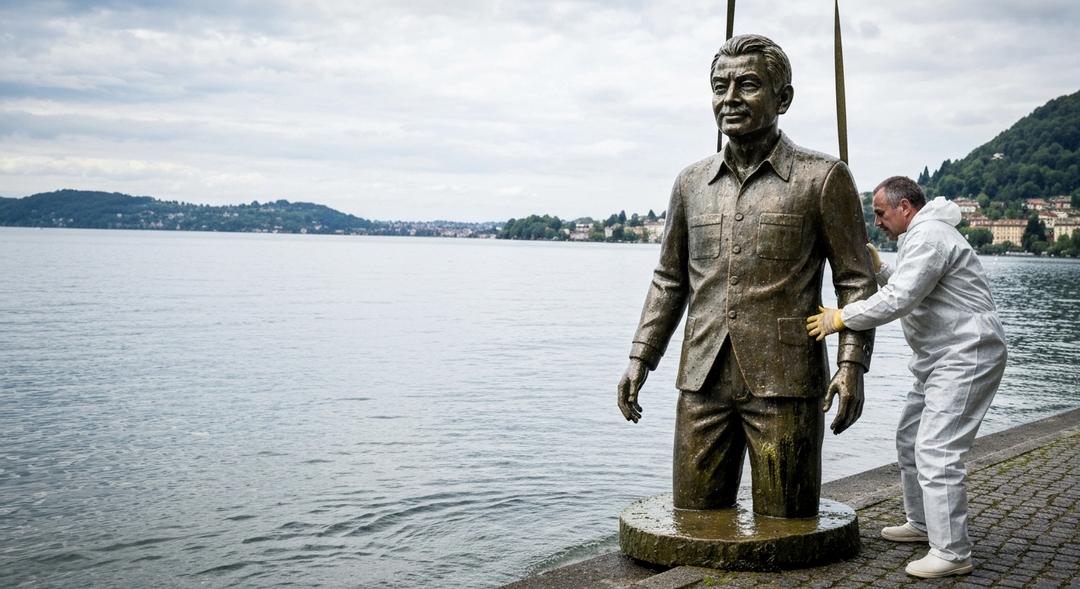A missing statue of Satoshi Nakamoto has finally reappeared in Lugano. The striking art piece, designed by Italian creator Valentina Picozzi, was found in a nearby lake following a citywide search.
News of the disappearance broke after Satoshigallery, the group behind the installation, reported the statue gone on August 3. The work had only been in place since the previous October, where it made its debut at Plan B’s Bitcoin forum as Lugano worked to showcase its growing role in the world of cryptocurrency.
The statue, well known for its optical illusion effect involving layers and fading stripes, quickly became a symbol for the city’s ambition. It honored the pseudonymous creator of Bitcoin, Satoshi Nakamoto, and soon attracted attention from both locals and visitors.
Observant residents first noticed the statue missing, and initial reports suggested it may have been taken during Swiss National Day festivities. One user on social media speculated that with surveillance cameras around the city, any thieves could only have hidden it in the water nearby.
Satoshigallery soon offered a reward of 0.1 BTC to anyone who could help recover the stolen artwork. Their public appeal echoed the communal values of the cryptocurrency movement, promising that while a symbol might be stolen, the shared vision and commitment remained.
Picozzi, the artist, wasted no time once the statue was located. Images spread across social platforms, showing the statue being retrieved from the lake, though the extent of the damage remains unknown.
In response to the incident, Picozzi mentioned the possibility of using the kintsugi technique as part of the restoration. Kintsugi, a centuries-old Japanese art, involves mending broken objects with lacquers mixed with precious metals like gold or silver, highlighting the marks of repair instead of hiding them.
The suggestion of kintsugi struck a chord with the community, blending the ideas of resilience, value and transformation. The community’s response was swift as well, with a petition launched on a popular platform urging the city of Lugano to provide logistical and security support for the restoration effort.
Significantly, Picozzi offered to take on the costs of restoration herself. Her gesture was noted in the petition and widely supported, representing a personal dedication to the preservation of this important artwork.
The recovery of the statue comes close on the heels of another milestone. Just over a week before the theft in Lugano, Satoshigallery had unveiled their third Satoshi Nakamoto statue, this time in Tokyo, underlining the international reach of the project.
This public art initiative aims to connect the world’s growing interest in digital currencies to physical spaces and cultural expressions. Each statue brings a new layer of engagement and discussion among communities, as the enigmatic figure of Satoshi Nakamoto continues to inspire artists and advocates alike.
Installations like these serve as more than simple tribute. They prompt dialogue about privacy, technology, and the future of finance in an increasingly digitized world. By capturing the public imagination, these statues reinforce how digital innovation is shaping cities, from Tokyo to Lugano.
For the city of Lugano, embracing Bitcoin is part of a wider effort to position itself as a hub for blockchain development and digital finance. Unveiling the Satoshi Nakamoto statue was an integral milestone in highlighting this vision. Unforeseen events, such as this theft, only underscore the significance of the project and the sharp attention the city now draws within the industry.
Local citizens and cryptocurrency enthusiasts worldwide watched with relief as the missing statue was returned. The story has highlighted not only the power of art to unite, but also the commitment of the digital assets community to protect and celebrate its symbols.
Within this broader narrative, those looking to participate in the world of digital mining have found increasing opportunities to Start Cloud Mining. This movement offers new ways for individuals to engage with cryptocurrency without needing physical infrastructure, reflecting the shift from physical to virtual domains that stories like Lugano’s bring into sharp focus.
While the city assesses the statue’s condition and plans next steps, the story of the Satoshi Nakamoto statue continues to evolve. This journey from loss to recovery has captivated both locals and the global cryptocurrency audience, reinforcing the shared sense of purpose behind technological change.
Conclusion
The saga of the missing Satoshi Nakamoto statue has sparked international interest, blending elements of art, technology and community resilience. As conversations about restoration unfold and support pours in, Lugano’s commitment to embracing digital innovation remains undiminished.
The response from the public, authorities and the artist herself demonstrates a collective determination to safeguard the vision that these creations represent. In the ongoing intersection of culture and cryptocurrency, such stories remind us of the growing importance of digital symbols in shaping our modern world.

Ewan’s fascination with cryptocurrency started through his curiosity about innovative technologies reshaping the financial world. Over the past four years, he has specialized in cloud mining and crypto asset management, diving deep into mining contracts, profitability analysis, and emerging trends. Ewan is dedicated to helping readers understand the technical and economic aspects of crypto mining, making complex information accessible and actionable.




